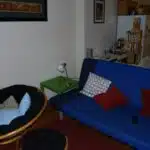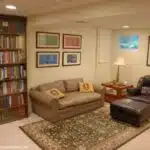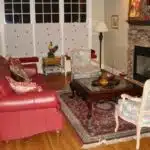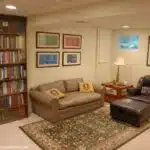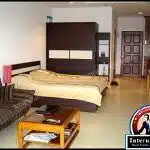As a home decorating expert, it is my duty to inform you that the appearance of your home speaks volumes about your personality and style. A well-decorated home not only creates a welcoming atmosphere but also adds value to your property. However, there are certain decor choices that can make your home look cheap and uninviting. In this article, I will be sharing ten things that make a home look cheap and how you can avoid them.
The key to avoiding cheap-looking decor is to focus on quality over quantity. Many people assume that having more items in their home will make it look more luxurious, but this couldn’t be further from the truth. Instead, investing in high-quality items such as furniture, artwork, and accessories will elevate the overall look of your home. Additionally, paying attention to small details such as lighting, color schemes, and texture can make a big difference in creating a stylish and sophisticated space. So let’s dive into the top 10 things that make a home look cheap and learn how to avoid them for an elegant and inviting living space.
Overuse Of Plastic Furniture
The overuse of plastic furniture is a common mistake that many homeowners make when decorating their homes. While plastic furniture can be affordable and easy to clean, it can easily make a home look cheap and uninviting. Plastic chairs, tables, and other pieces of furniture are often seen as disposable items that do not have any aesthetic or functional value.
Thankfully, there are alternatives to plastic furniture that can help elevate the overall design of your home. For instance, you can opt for wooden or metal furniture, which are more durable and stylish. These materials come in various finishes and styles, making them versatile enough to fit any interior design theme. Additionally, they can last for years with proper care and maintenance.
When choosing durable furniture for your home, consider the materials used in its construction, as well as the quality of its finishing. Look for pieces that have sturdy frames made of solid wood or metal. Avoid lightweight pieces that may easily break or tip over with regular use. By investing in high-quality furniture made from durable materials, you can ensure that your home looks stylish and inviting for years to come.
Cluttered Spaces
Walking into a home that is cluttered with too many knick-knacks and random objects can be overwhelming. A cluttered space can make it difficult to focus on the overall design of a room, and instead, your eyes are drawn to the mess. Minimalist decor can help transform a cluttered space into a more serene environment.
Simple color schemes are also an important factor when it comes to creating an aesthetically pleasing home. Rooms painted in bright or bold colors can appear cheap and chaotic if not executed correctly. Instead, consider using neutral tones like white, beige, or gray as a base for your walls and furniture. When accessorizing, add pops of color with throw pillows, curtains or artwork to create visual interest without overwhelming the space.
To create a minimalist look in your home, start by decluttering your space. Remove any items that do not serve a purpose or bring you joy. Once you have pared down your belongings, invest in storage solutions like bookcases or baskets to keep things organized and out of sight. Remember that less is often more when it comes to home decor.
As important as decluttering and simplifying the design elements of a room may be, there are other factors that contribute to making a house look cheap such as dated or worn-out carpeting. To avoid this pitfall, consider updating flooring with hardwoods or tile which will give the room an updated look while also being easier to clean and maintain.
Dated Or Worn-Out Carpeting
A cluttered home can look cheap and uninviting, but so can a home with dated or worn-out carpeting. While some may think that simply cleaning the carpets will solve the problem, sometimes it’s best to replace them altogether. Cleaning can help in certain situations, but if your carpet is significantly worn out or outdated, then replacing it may be the better option.
Replacing vs cleaning: which is more cost effective for dated or worn out carpeting? This depends on the condition of your current carpet. If it’s just a bit shabby or stained, cleaning it may be enough to give it a new lease on life. However, if it’s threadbare or has lost its texture and color, then replacing it is probably the better solution. It may seem like an expensive undertaking, but in the long run, you’ll save money by not having to clean and maintain old carpet that will only continue to deteriorate.
How to choose the right carpet for your home without breaking the bank? The key is to find a balance between quality and affordability. Look for carpets made from durable materials such as nylon or polyester that are also stain-resistant and easy to clean. Avoid trendy patterns and colors that may be out of style in a few years and opt for neutral shades that will complement any future decor changes. Don’t be afraid to shop around and compare prices from different retailers – you may even be able to find great deals on discount carpets online or at local warehouse stores.
As important as choosing the right type of carpet is ensuring that there’s cohesion in design throughout your home. A mismatched look can make your space appear disjointed and cheap. In our next section, we’ll explore how lack of cohesion in design can negatively impact the overall look and feel of your home – and what you can do about it.
Lack Of Cohesion In Design
As a home decorating expert, I have seen numerous homes with design elements that lack cohesion. Such interiors are often a hodgepodge of furniture and accessories from different styles and eras, making the spaces look cluttered and cheap. Creating a cohesive home design is crucial for those who want to make their homes look luxurious and sophisticated.
One way to achieve a cohesive design is by selecting a unifying theme or color scheme for the entire house. This could be something as simple as using similar shades of white or cream throughout the rooms, or it could be a more complex theme such as coastal or mid-century modern. Whatever you choose, make sure that the theme runs consistently throughout the space.
Another common mistake homeowners make is mixing different design styles without considering how they will work together. While it can be tempting to incorporate pieces from various eras and styles, it’s important to do so thoughtfully. For instance, pairing an antique sofa with contemporary artwork might not work unless there are other elements in the room that tie them together. Dos and don’ts must be kept in mind while mixing different design styles.
To sum up, creating a cohesive home design takes careful planning and consideration. Choose a unifying theme or color scheme for your home and make sure that it runs consistently throughout each room. Be mindful of mixing different design styles by keeping in mind dos and don’ts to avoid creating an interior that looks tacky and cheap. In the subsequent section, we will discuss another factor that can contribute to an unappealing interior: tacky or oversized decor.
Tacky Or Oversized Decor
Oversized decor can be a great way to make a statement in your home, but it’s important to know when it’s too much. Large pieces of furniture or artwork can easily overwhelm a space and make it feel cluttered or cramped. To incorporate oversized decor tastefully, start by choosing one or two statement pieces and letting them shine as the focal points of the room. It’s also important to consider scale – if you have high ceilings or lots of open space, larger pieces may work well, but in smaller rooms, it’s best to stick with smaller-scale decor.
Plastic furniture is a common culprit when it comes to making a home look cheap. While it may be tempting due to its affordability, there are plenty of alternatives that can make your space look more sophisticated. Consider investing in quality wood or metal furniture that will last for years and add timeless style to your home. If budget is a concern, look for secondhand pieces that can be refinished or reupholstered for a custom look at a fraction of the cost.
Incorporating oversized decor and avoiding plastic furniture are just two ways to elevate the look of your home. In the next section, we’ll explore another common mistake: leaving blank or bare walls. With the right wall decor, you can add personality and warmth to any room while creating a cohesive design scheme throughout your entire home.
Blank Or Bare Walls
- Bare walls often make a home look cheap and uninviting if not decorated with artwork or wallpaper.
- Lack of artwork in particular can be a major contributor to a room appearing unfinished and austere.
- Plain wallpaper is another way to make a room look dull and uninteresting, and should be avoided in favor of an engaging and colorful pattern.
- Taking the time to pick out the right artwork and wallpaper can have a huge impact on the overall look of a room, and make it much more inviting.
Lack Of Artwork
Walking into a home with empty walls can feel like walking into a sterile and lifeless space. Blank or bare walls are often a sign of neglect in the decoration process, leaving an impression of an incomplete and uninviting environment. Lack of artwork is one of the primary reasons behind this aesthetic blunder, but fortunately, there are many affordable ways to add art to your home.
One way to incorporate artwork into your home decor is by choosing pieces that complement the overall theme of your living space. For example, if you have a minimalist design style in your home, you may want to choose simple and abstract art pieces that will not overwhelm your living space. On the other hand, if you have a more eclectic style with vibrant colors and patterns, you may want to opt for bold and colorful artwork that will add depth and character to your walls.
Another way to inexpensively add art to your home is by creating it yourself or supporting local artists. You can try creating paintings or prints on canvas or paper using acrylic paint or watercolors. If you’re not artistically inclined, visit local art fairs or galleries for affordable options from budding artists. These unique pieces will not only enhance the aesthetic appeal of your home but also support local talent in the community.
Incorporating artwork into your home decor does not have to be expensive nor challenging. There are various affordable ways to add art that will elevate the aesthetic appeal of even the most mundane living spaces. So go ahead and experiment with different styles and mediums until you find what best expresses your personality while transforming blank walls into artistic masterpieces.
Plain Wallpaper
Blank walls can be a source of frustration for homeowners who want to create a welcoming and aesthetically pleasing living space. One solution to this problem is plain wallpaper, which offers an easy way to add texture and interest to any room. Choosing the right pattern and style of wallpaper can make all the difference in transforming a dull wall into a stunning focal point.
When selecting patterns for your plain wallpaper, it’s important to consider the overall design theme of your home. If you have a contemporary or minimalist aesthetic, opt for subtle patterns such as geometric shapes or simple stripes. For those who prefer bold colors and patterns, go for more daring designs like floral prints or large-scale graphics. Combining different textures and patterns can also create depth and contrast in your space.
If you’re not quite ready to commit to traditional wallpaper, there are plenty of alternatives available that can achieve the same effect without the permanent installation. Removable peel-and-stick wallpaper is an excellent option for renters or those who like to switch up their decor frequently. Stencils are another budget-friendly alternative that allows homeowners to create their own unique designs on a blank wall. Finding the right balance between boldness and subtlety will ensure that your chosen wallpaper style aligns with your personal preferences while elevating the visual appeal of your home.
In conclusion, plain wallpaper is an effective way to add character and charm to any room while creating an inviting atmosphere. By choosing patterns that complement your existing decor style, you can transform any bland wall into an artistic masterpiece without breaking the bank. Whether you opt for traditional or alternative forms of wallpaper, finding the right balance between boldness and subtlety will allow you to achieve the perfect look for your unique living space.
Poor Lighting Choices
Blank or bare walls can certainly make a home look cheap, but poor lighting choices can also contribute to this effect. Lighting placement is crucial when it comes to creating an inviting and cozy atmosphere within your home. Improperly placed lights can create harsh shadows and unflattering angles, making even the most expensive decor look cheap.
When selecting light fixtures for your home, it’s important to choose styles that complement your decor and add to the overall aesthetic appeal. Avoid outdated or overly trendy fixtures that may quickly become dated and detract from the value of your home. Consider investing in quality fixtures that will stand the test of time and provide ample light throughout your living spaces.
In addition to proper placement and stylish fixtures, it’s also important to consider the type of lighting you’re using in each room. Harsh fluorescent lighting should be avoided in favor of softer, warmer tones that create a more welcoming ambiance. By taking these factors into account, you can avoid common lighting mistakes that make a home look cheap and instead create a warm and inviting atmosphere that will impress guests for years to come.
Transition: While proper lighting can go a long way towards elevating the appearance of your home, don’t forget about another crucial element – window treatments. Cheap curtains or blinds can undo all of your hard work when it comes to creating an inviting space, so be sure to keep reading for tips on how to elevate this often-overlooked aspect of interior design.
Cheap Window Treatments
Did you know that the average American homeowner spends around $1,200 on window treatments? With so many options available, it’s easy to get carried away and overspend. However, there are affordable window treatments that can still elevate the look of your home without breaking the bank.
Window treatment trends come and go, but some classic styles never go out of fashion. For a timeless look, consider investing in neutral-colored curtains or blinds. These can easily match any decor style and won’t clash with other patterns or colors in your room. Sheer curtains also add a touch of elegance while allowing natural light to fill your space.
When it comes to cheap window treatments, avoid flimsy materials like plastic or paper shades. Instead, opt for budget-friendly alternatives like bamboo or woven wood shades. Not only do these materials add texture and warmth to your home, but they’re also eco-friendly and sustainable. Plus, they offer privacy while still letting sunlight filter through.
Moving forward from finding an affordable yet elegant solution for windows treatment there is another aspect that we need to focus on; Inappropriate artwork.
Inappropriate Artwork
Cheap window treatments can make a home look uninviting and unappealing. However, inappropriate artwork can also have the same effect. Choosing the right pieces of artwork to display in your home is essential to creating an inviting, well-decorated space.
When selecting artwork for your home, consider the style and color scheme of each room. The art you choose should complement the existing decor and tie everything together. If you want to create a cohesive look throughout your home, select pieces that have similar colors or themes. Avoid choosing art that clashes with the rest of your decor as it will make your home look disjointed.
Once you’ve chosen the appropriate artwork for each room, it’s important to display it correctly. Avoid hanging too many pieces in one area as it can make a space feel cluttered and overwhelming. Instead, opt for larger pieces or group smaller ones together in a gallery-style arrangement. Make sure to hang art at eye level so that it’s easily visible and doesn’t get lost in the rest of your decor.
- When done correctly, displaying artwork in your home can evoke feelings of warmth and comfort.
- Sub-list 1: It can add personality to a space and showcase your unique tastes and interests.
- Sub-list 2: It can also serve as a conversation starter when entertaining guests.
Tips for displaying artwork without making your home look cheap:
- Don’t be afraid to invest in quality pieces of art
- Frame each piece properly
- Consider using lighting to highlight certain pieces
Incorporating appropriate artwork into your interior design is crucial for creating an inviting atmosphere within your home. By taking into account the colors and themes already present within each room, carefully selecting each piece of art, and displaying them appropriately, you’ll be able to create a cohesive aesthetic that will leave guests feeling welcomed and impressed.
As much as DIY projects are fun, there comes a time where they may become overwhelming and unnecessary in your home decor.
Too Many Diy Projects
While DIY projects can be a fun and cost-effective way to spruce up your home, too many DIY fails can make it look cheap and poorly done. It’s important to strike a balance between creativity and professionalism. Budget-friendly alternatives are available that will give your home the same aesthetic appeal without sacrificing quality.
DIY vs professional: pros and cons should be weighed carefully before embarking on any project. While DIY projects can save money, they require skill, time, and materials. Professional contractors have the experience to complete projects quickly and efficiently, but their services come at a higher price point. If you decide on a DIY project, be sure to do thorough research beforehand and have realistic expectations of your skill level.
Instead of taking on too many DIY projects, consider budget-friendly alternatives such as affordable decor items or repurposing existing furniture. These options can give your home an updated look without requiring extensive work. Remember that quality should always come first when decorating your home. A lack of attention to detail or cutting corners for the sake of saving money will ultimately result in a cheap-looking space.
As we move away from discussing too many DIY projects, it’s important to address another common issue that makes homes look cheap: lack of quality flooring.
Lack Of Quality Flooring
One of the biggest culprits in making a home look cheap is having low-quality flooring. This can come in many forms, from dingy carpet to outdated linoleum. Fortunately, there are plenty of options for upgrading your floors that won’t break the bank.
One option is to install hardwood flooring. While it may seem expensive upfront, hardwood has numerous benefits that make it worth the investment. Not only does it add warmth and character to a room, but it’s also durable and long-lasting. Plus, hardwood floors are easy to clean and maintain, making them a great choice for busy households.
If you’re not ready to commit to hardwood just yet, choosing the right carpet can also make a big difference in how your home looks and feels. Opt for high-quality materials like wool or nylon that will stand up to wear and tear over time. And don’t be afraid to experiment with color and texture – a bold patterned rug can be just what you need to add some personality to a space.
With so many options available, there’s no reason why your home should suffer from lackluster flooring. By investing in quality materials like hardwood or high-end carpeting, you’ll instantly elevate the look and feel of any room in your house.
Transition: While updating your floors can go a long way towards improving the overall look of your home, there are other decorating mistakes that can detract from its appeal as well. One such mistake is excessive use of mirrors…
Excessive Use Of Mirrors
- When using reflective surfaces, it is important to use them in moderation so as to not overdecorate a space.
- Too many reflective surfaces can make a home look cheap and can distract from other design elements.
- Overdecorating a home can make it appear cluttered and cause it to lose its sense of style and sophistication.
- When it comes to mirrors, it is best to use them sparingly and strategically to maximize the design of the space.
Reflective Surfaces
When it comes to home decor, mirrors are a popular choice to enhance the aesthetics of a space. However, when used excessively, they can make a home look cheap and tacky. Reflective surfaces have the potential to create an illusion of increased space and light in a room, but innovative uses are necessary to avoid going overboard.
One maintenance tip is to clean mirrors regularly as smudges and streaks can make them look dingy. Another way to avoid excessive use is by choosing unique shapes and styles of mirrors that complement the room’s decor. Oversized or oddly shaped mirrors can add character and depth without overwhelming the space.
In conclusion, reflective surfaces like mirrors can be a great addition to any home decor if used correctly. Innovative uses and maintenance tips can ensure that your home looks elegant rather than cheap. So be creative with mirror placement and choose unique shapes and sizes for an elevated aesthetic appeal.
Overdecorating
Moving on from excessive use of mirrors, another common mistake in home decor is overdecorating. When it comes to decorating a space, less is often more. Overdoing it with too many accessories and decor items can clutter a room and make it feel overwhelming. It’s important to strike a balance between adding personality to a space and keeping it functional.
One way to avoid overdecorating is through color coordination. A cohesive color scheme can tie together different elements in a room and create a sense of unity. Instead of using too many patterns or colors, stick to one or two complementary hues and incorporate them throughout the space. This will give the room an organized look that feels intentional.
In addition, practicing minimalism can prevent overdecorating. Minimalism doesn’t mean having nothing in your home but rather selectively choosing pieces that serve both form and function. This approach allows for breathing room in a space, making it feel more open and inviting. By focusing on quality over quantity, you can elevate the style of your home without going overboard with decor items that don’t add value to the space.
Ill-Fitting Or Poor Quality Curtains
When it comes to dressing up your windows, choosing the right curtains is key. Ill-fitting or poor quality curtains can make a home look cheap and uninviting. However, with a little bit of knowledge, you can easily choose curtains that fit perfectly and add a touch of luxury to your home.
Firstly, it’s important to measure your windows properly before purchasing curtains. Curtains that are too short or too long will not only look awkward but also make your space appear cramped. Measure the height from the top of the window frame to the floor and add a few inches to achieve an elegant drape. For width, measure the entire length of the curtain rod and add an additional 4-8 inches on each side for optimal coverage.
Investing in high-quality curtains has numerous benefits. Not only do they elevate the overall aesthetics of your home, but they also offer practical benefits such as energy efficiency, noise reduction, and privacy. Opt for materials like silk or linen for a luxurious feel or consider blackout curtains if you’re looking to create a cozy and private environment.
As you can see, choosing well-fitted and quality curtains is crucial in creating a polished interior design scheme for your home. In our next section, we will discuss another common mistake that can make your space look cheap – overuse of bright colors.
Overuse Of Bright Colors
Color coordination is a crucial aspect of home decorating. While the use of bright colors can add vibrancy and energy to a space, overusing them can make a home look cheap and tacky. One common mistake is using too many bright colors without considering their compatibility with each other. This can result in an uncoordinated mishmash of hues that clash rather than complement each other.
To avoid this problem, it’s important to choose a color scheme that works well together. Start by selecting one or two bold colors and use them as accents throughout the room. Then, balance these bright colors with neutrals such as white, beige, or gray. This will help neutralize the brightness while still allowing the accents to stand out. Additionally, using patterns with similar color schemes can also be effective in creating visual harmony and cohesion.
One way to add interest to a space without overwhelming it with bright colors is by incorporating accents. These could be throw pillows, curtains, or decorative pieces that have complementary hues to the overall color scheme. Neutralizing with accents allows for pops of color without overpowering the space. It’s essential not to overdo it though; too many accents can have the opposite effect and make a room appear cluttered and chaotic. By carefully balancing bright colors with neutrals and using accents in moderation, you can create a stylish and sophisticated look for your home.
Transition into subsequent section: Proper color coordination is essential when decorating your home; however, it’s not just about choosing the right hues for your walls and accessories. The quality of your bedding or linens also plays an important role in elevating the overall aesthetic of your living spaces.
Low-Quality Bedding Or Linens
When it comes to making a home look expensive, one of the most overlooked areas is bedding and linens. Low-quality bedding can instantly make a room feel cheap and uninviting. It’s important to invest in high-quality bedding options that will not only last longer but also provide maximum comfort.
One key factor to consider when selecting bedding options is the material used for the linens. Cotton is a popular choice because of its softness and breathability, while silk adds elegance and luxury to any bedroom. Linen materials are also becoming more popular due to their durability and natural texture.
In addition to material, the style of the bedding can also impact the overall aesthetic of a room. A simple white duvet cover can add a touch of sophistication, while patterned or brightly colored sheets can create a fun and playful atmosphere. When selecting bedding options, be sure to choose styles that complement the existing decor in the room for a cohesive look. By investing in high-quality bedding materials and selecting styles that elevate the overall aesthetic of a room, you can create an inviting space that feels both luxurious and comfortable.
Conclusion
As a home decorating expert, it is essential to understand that one’s home is a reflection of their personality and style. Unfortunately, there are certain things that can make even the most well-intentioned homeowner’s efforts look cheap and tacky. We have identified ten potential pitfalls that homeowners should steer clear of if they want their homes to look chic and sophisticated.
Firstly, overuse of plastic furniture can make a home look like a college dorm room rather than an elegant living space. Cluttered spaces can also create an unappealing aesthetic, leaving guests feeling overwhelmed and uncomfortable. Dated or worn-out carpeting is another no-no; it can be an eyesore and make even the most beautiful furniture pieces appear outdated.
Additionally, lack of cohesion in design can make a home feel disjointed and chaotic. Tacky or oversized decor items can quickly turn an otherwise lovely room into a circus-like atmosphere. Excessive use of mirrors can be disorienting for guests and create an illusion of clutter. Ill-fitting or poor quality curtains are also problematic since they cheapen the overall look of the space.
Furthermore, overuse of bright colors has the potential to overwhelm visitors’ senses and even cause headaches in some cases. Finally, low-quality bedding or linens will give guests the impression that you do not care about their comfort or wellbeing.
In conclusion, by avoiding these common decorating mistakes, homeowners can elevate their living spaces to new heights of sophistication and elegance. Remember to choose high-quality pieces that complement each other seamlessly while avoiding anything too flashy or cheap-looking. With these tips in mind, anyone can create a truly stunning home environment that will impress visitors for years to come!
Image Credits
- “cp_fr32 – ‘Cheap Perfume’ All-Girl-Band cbgb maxskansascity -©s. fitzstephens1978->2011©” by s76fitz (featured)





